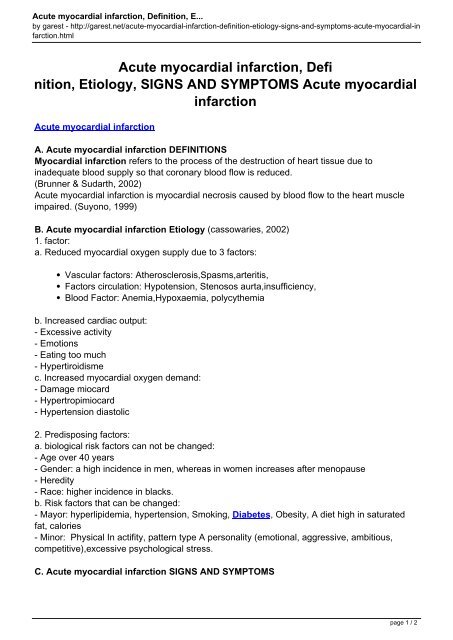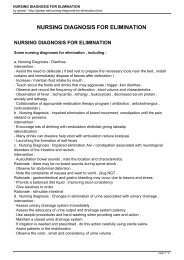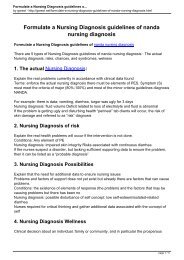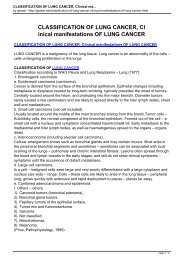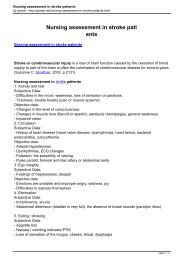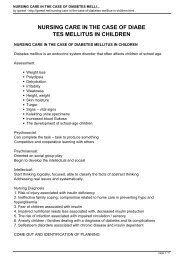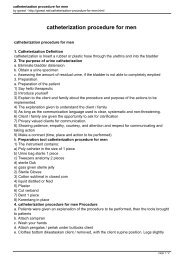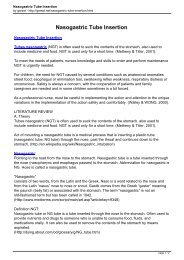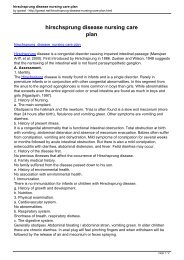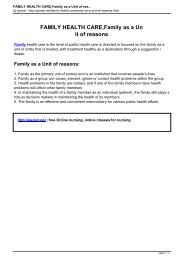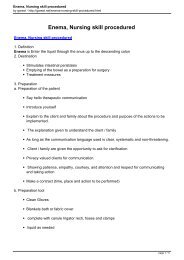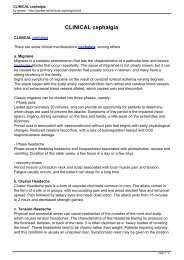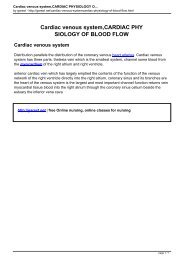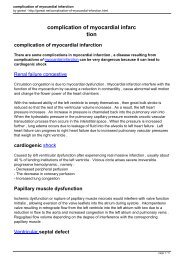Acute_myocardial_infarction_Definition_Etiology_SIGNS_AND_SYMPTOMS_Acute_myocardial_infarction.pdf
Create successful ePaper yourself
Turn your PDF publications into a flip-book with our unique Google optimized e-Paper software.
<strong>Acute</strong> <strong>myocardial</strong> <strong>infarction</strong>, <strong>Definition</strong>, E...<br />
by garest - http://garest.net/acute-<strong>myocardial</strong>-<strong>infarction</strong>-definition-etiology-signs-and-symptoms-acute-<strong>myocardial</strong>-in<br />
farction.html<br />
<strong>Acute</strong> <strong>myocardial</strong> <strong>infarction</strong>, Defi<br />
nition, <strong>Etiology</strong>, <strong>SIGNS</strong> <strong>AND</strong> <strong>SYMPTOMS</strong> <strong>Acute</strong> <strong>myocardial</strong><br />
<strong>infarction</strong><br />
<strong>Acute</strong> <strong>myocardial</strong> <strong>infarction</strong><br />
A. <strong>Acute</strong> <strong>myocardial</strong> <strong>infarction</strong> DEFINITIONS<br />
Myocardial <strong>infarction</strong> refers to the process of the destruction of heart tissue due to<br />
inadequate blood supply so that coronary blood flow is reduced.<br />
(Brunner & Sudarth, 2002)<br />
<strong>Acute</strong> <strong>myocardial</strong> <strong>infarction</strong> is <strong>myocardial</strong> necrosis caused by blood flow to the heart muscle<br />
impaired. (Suyono, 1999)<br />
B. <strong>Acute</strong> <strong>myocardial</strong> <strong>infarction</strong> <strong>Etiology</strong> (cassowaries, 2002)<br />
1. factor:<br />
a. Reduced <strong>myocardial</strong> oxygen supply due to 3 factors:<br />
Vascular factors: Atherosclerosis,Spasms,arteritis,<br />
Factors circulation: Hypotension, Stenosos aurta,insufficiency,<br />
Blood Factor: Anemia,Hypoxaemia, polycythemia<br />
b. Increased cardiac output:<br />
- Excessive activity<br />
- Emotions<br />
- Eating too much<br />
- Hypertiroidisme<br />
c. Increased <strong>myocardial</strong> oxygen demand:<br />
- Damage miocard<br />
- Hypertropimiocard<br />
- Hypertension diastolic<br />
2. Predisposing factors:<br />
a. biological risk factors can not be changed:<br />
- Age over 40 years<br />
- Gender: a high incidence in men, whereas in women increases after menopause<br />
- Heredity<br />
- Race: higher incidence in blacks.<br />
b. Risk factors that can be changed:<br />
- Mayor: hyperlipidemia, hypertension, Smoking, Diabetes, Obesity, A diet high in saturated<br />
fat, calories<br />
- Minor: Physical In actifity, pattern type A personality (emotional, aggressive, ambitious,<br />
competitive),excessive psychological stress.<br />
C. <strong>Acute</strong> <strong>myocardial</strong> <strong>infarction</strong> <strong>SIGNS</strong> <strong>AND</strong> <strong>SYMPTOMS</strong><br />
page 1 / 2
Powered by TCPDF (www.tc<strong>pdf</strong>.org)<br />
<strong>Acute</strong> <strong>myocardial</strong> <strong>infarction</strong>, <strong>Definition</strong>, E...<br />
by garest - http://garest.net/acute-<strong>myocardial</strong>-<strong>infarction</strong>-definition-etiology-signs-and-symptoms-acute-<strong>myocardial</strong>-in<br />
farction.html<br />
Signs and symptoms of <strong>myocardial</strong> <strong>infarction</strong> (TRIAD) is:<br />
1. Pain:<br />
a. Chest pain that occurs suddenly and constantly not subside, usually above the sternal<br />
region and upper abdomen, this is the main symptom.<br />
b. The severity of pain can increase secaara settled until the pain becomes unbearable.<br />
c. Pain is very sick, such as punctured and needles that can spread to the shoulder and<br />
continues down the arm (usually the left arm).<br />
d. The pain began spontaneously (not happening after the activity or emotional disturbance),<br />
persist for several hours or days, and not relieved by rest or nitroglycerin assistance (NTG).<br />
e. The pain may spread to the jaw and neck.<br />
f. Pain is often accompanied by shortness of breath, pale, cold, severe diaphoresis, dizziness<br />
or head was floating, and nausea and vomiting.<br />
g. Patients with diabetes mellitus will not experience severe pain because of neuropathy that<br />
accompanies diabetes can interfere neuroreseptor (accumulated experience of pain).<br />
2. Laboratory<br />
Examination Cardiac enzymes:<br />
a. CPK-MB/CPK<br />
Isoenzymes were found in the heart muscle to increase between 4-6 hours, peaks within 12-24<br />
hours, returning to normal within 36-48 hours.<br />
b. LDH / HBDH<br />
Increased within 12-24 hours dam takes longer to return to normal<br />
c. AST / SGOT<br />
Increases (less real / special) occurs within 6-12 hours, culminating in 24 hours, returning to<br />
normal within 3 or 4 days<br />
d. Troponin<br />
3. ECG<br />
ECG changes that occur in the early phase of the T wave height and symmetrical. After this<br />
there is ST segment elevation. Change happens then is the wave Q / QS which indicates<br />
necrosis<br />
Pain scores <strong>Acute</strong> <strong>myocardial</strong> <strong>infarction</strong> according to White:<br />
0 = no pain<br />
1 = pain on one side without disturbing activity<br />
2 = more pain in one place and lead to disruption of activities, such as difficulty getting out of<br />
bed, it’s hard to bend the head and others.<br />
http://garest.net | free Online nursing, online classes for nursing<br />
page 2 / 2


